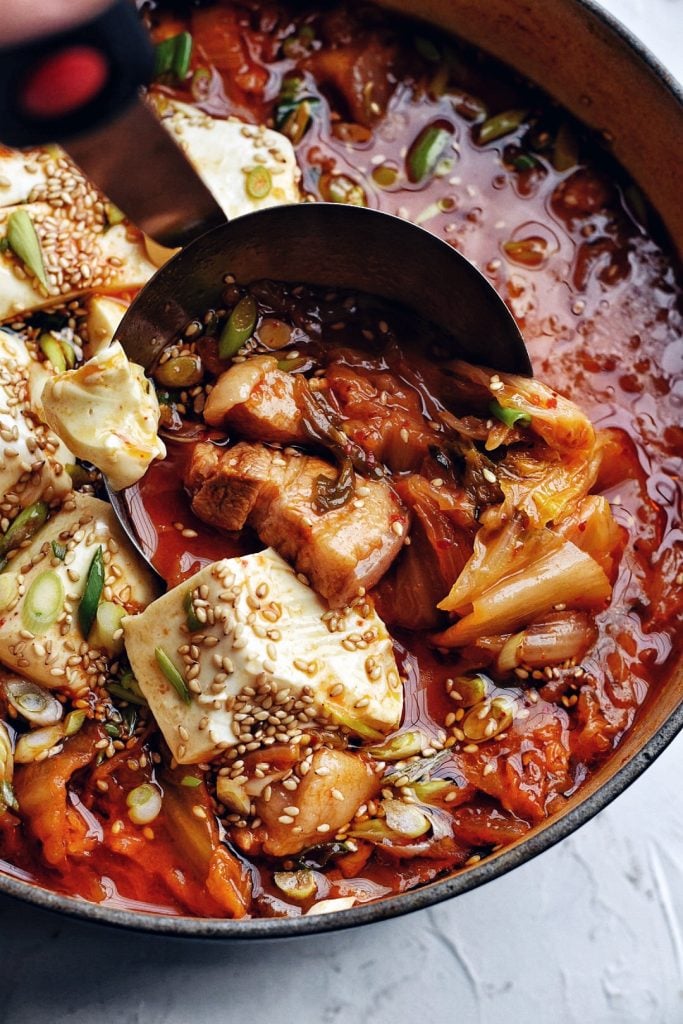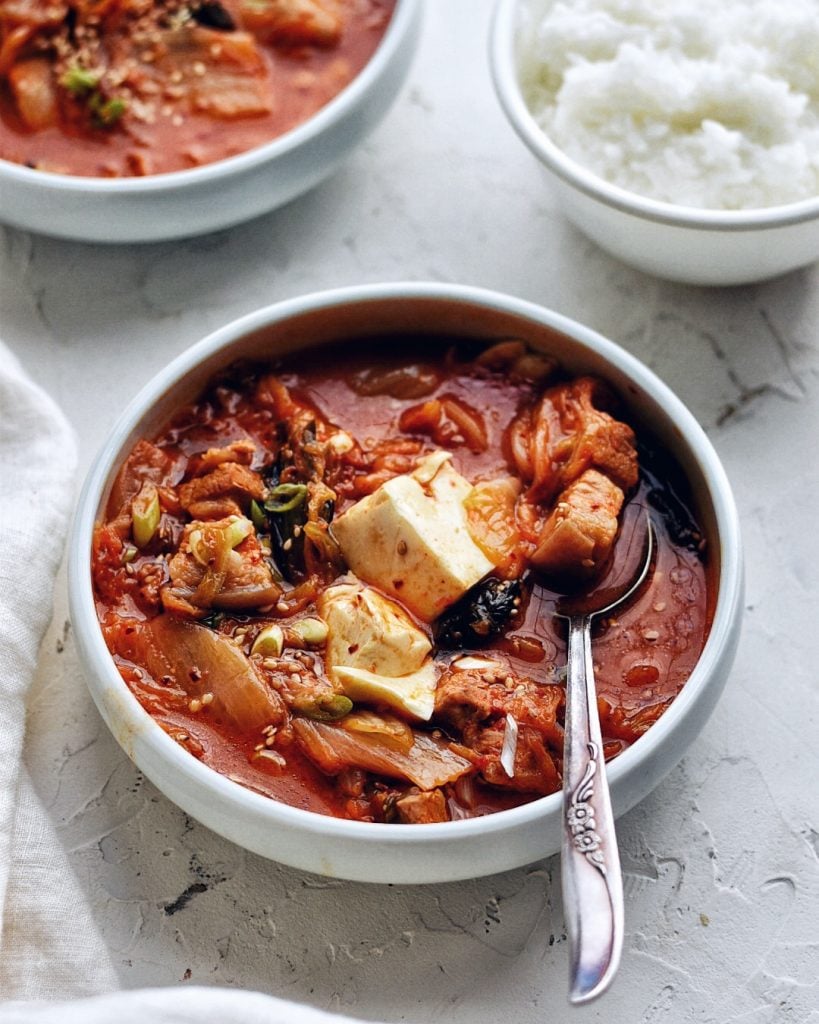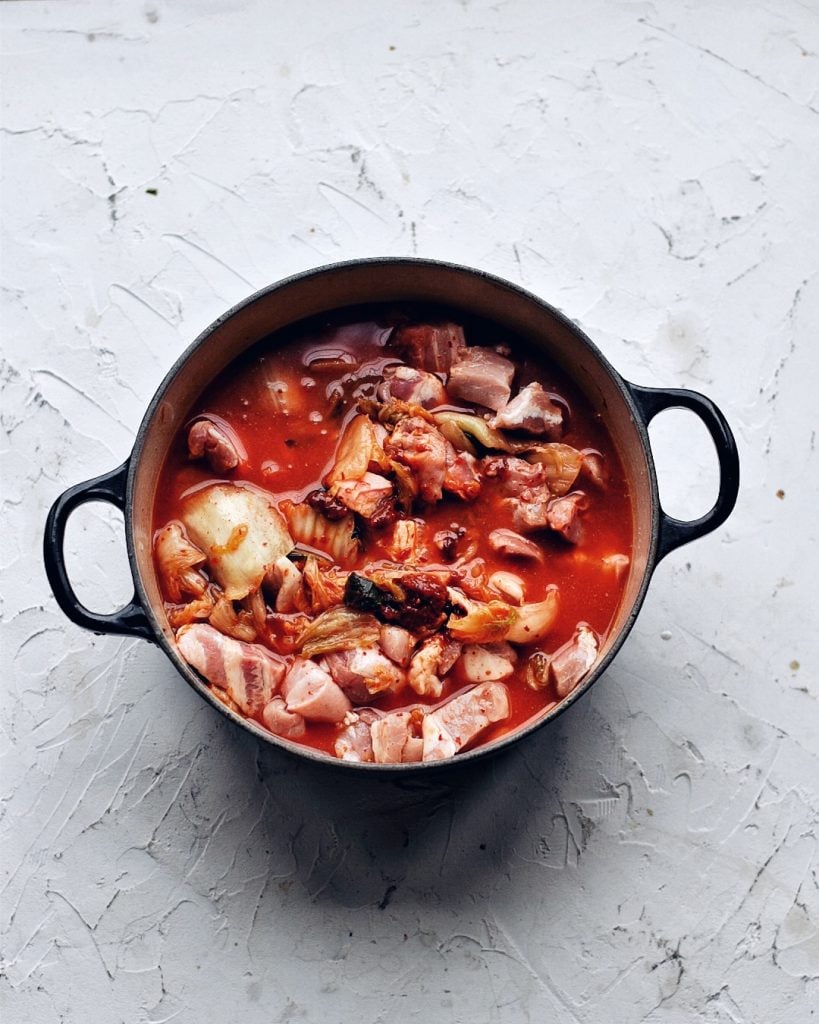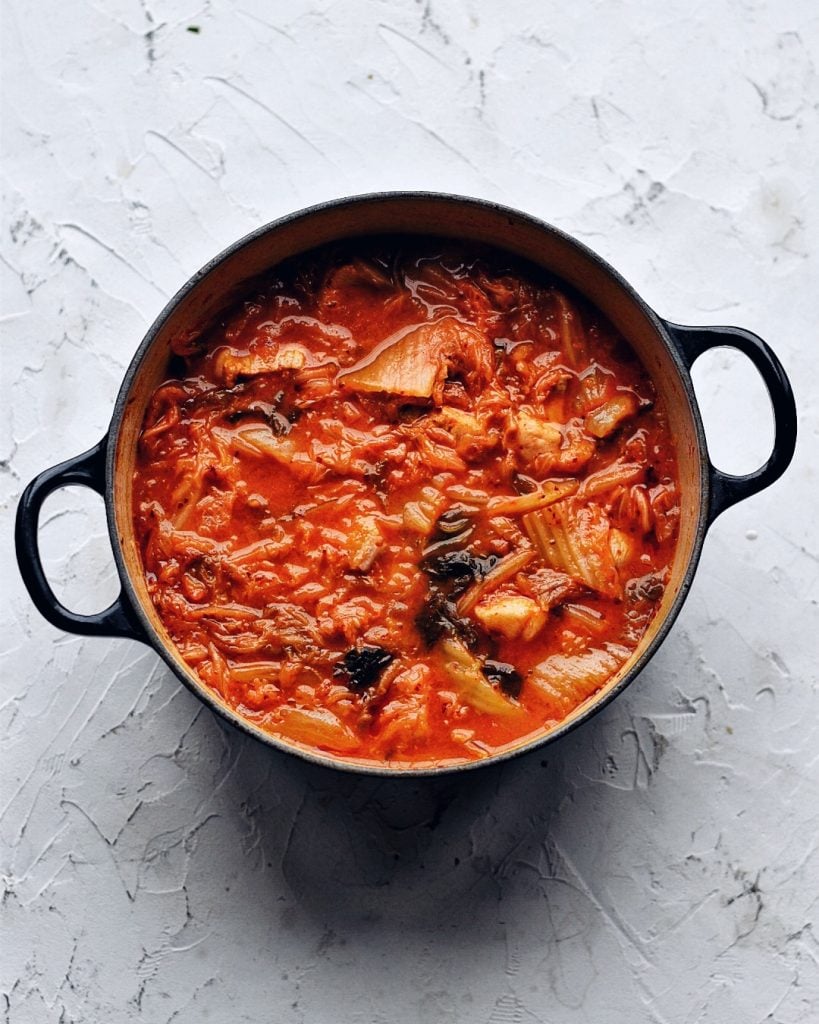Do you have old kimchi in your fridge? If so, it’s time to make easy and delicious Kimchi Jjigae! A traditional Korean stew, the spicy broth, tender pork belly, and jiggly tofu make this an absolute favorite. As a bonus, it’s so simple to make! The main ingredient is old kimchi. In fact, the older, the better! A staple of Korean home cooking that should be a part of your cooking rotation.
What is Kimchi Jjigae?
Kimchi Jjigae is a spicy stew and popular Korean dish made with old, well-fermented kimchi. The spicy flavors and tender chunks of pork belly make it irresistible. Also known as Kimchi Stew, it’s a classic Korean soup that’s regularly made at home. Minimal effort but maximum flavor!
To make the BEST Kimchi Jjigae recipe, it’s essential to use old kimchi. The kind of kimchi that’s so sour, it doesn’t taste good served at the table. But there’s no need to throw it away! Old kimchi means it’s time to make kimchi jjigae. The cooking process transforms aged kimchi into something deeply delicious.
Also, add anchovy broth (or anchovy tablets, to make it easier!) instead of water. It makes the difference between good kimchi jjigae and spectacular kimchi jjigae. Anchovy broth is the backbone of Korean cooking.
For deeper flavor, be sure to add some pork. Any kind of pork will do: pork chop, pork ribs, spam, or even hot dogs. Pork and kimchi are a classic pairing in Korean cuisine. The acidity of kimchi pairs well with the fattiness of pork.
I like to add two kinds of pork: pork belly and pork riblets. Fatty pork belly is cut into meaty chunks and cooked until tender in the spicy broth. They add heft and body to the soup. The pork riblets make the broth extra special — all that flavor and collagen from the connective tissue and bones!
Serve piping hot with a bowl of rice. Kimchi Jjigae is economical, hearty, healthy, and delicious. Pure comfort food and SO nourishing!

Why make Kimchi Stew at home?
- Easy to make. A true one-pot meal! Throw everything into a pot and let it boil away — that’s it!
- Versatile. Make it your own. Make it vegan, vegetarian, or extra meaty. Tastes great with a variety of proteins (tofu, pork, Spam, chicken, beef, canned tuna). Or, add rice cakes, ramen noodles, or udon noodles for more carby goodness.
- Exciting Flavors. Well-fermented, aged kimchi cooks down into a gloriously delicious, mouth-watering pot of soup. No boring flavors here!
- A great way to use up old kimchi. Don’t ever throw away an old jar of kimchi again!

Ingredients:
- Napa Cabbage Kimchi. The secret to a good Kimchi Jjigae recipe is old, well-fermented, aged kimchi. The older the kimchi, the better the kimchi jjigae. Do not use fresh kimchi — it won’t taste the same.
- Pork Belly. Kimchi + Pork = Korean BFFs! While any kind of pork works, fatty pork belly is such a luxurious addition. Cook until tender and jiggly for the ultimate comfort food.
- Pork Riblets. Makes Kimchi Jjigae extra delicious. The flavor and marrow from the bones make the most magical, deeply flavored broth. Use either pork ribs, pork riblets, or leftover pork chop bones.
- Anchovy Stock. Anchovy stock makes it extra flavorful and deep. To make it easier, use anchovy tablets or anchovy bouillon. They can both be found at Korean grocery stores. If you don’t have it, chicken broth, vegetable broth, or water also work.
- Gochujang. Korean fermented chili paste is a great flavor booster that also thickens the stew.
- Tofu. Add any kind you like. I enjoy the silky texture of Soft tofu but firm tofu is also good and doesn’t break apart as easily.
- Sesame Oil + Butter. Add right before serving for extra richness and fragrance.
- Sugar. Just a pinch to balance the acidity of the kimchi.
- Green onion + Sesame seeds. Optional garnish.

How to make Korean Kimchi Soup:
- Cook kimchi. *Optional Step*. Saute kimchi until caramelized and golden orange for an intensely flavorful kimchi flavor. *FYI: an optional step when the kimchi is not old enough or the kimchi is not great quality.*
- Simmer. In a large pot, add kimchi, water or anchovy stock, pork belly, pork riblets, and gochujang. Cover and bring to a boil. Lower heat and simmer until the pork is tender, about 25-30 minutes.
- Add tofu. Slice tofu and add directly on top. Simmer until warmed through, about 5 minutes.
- Garnish and serve! Add sesame seed oil and butter. Sprinkle green onions and sesame seeds. Enjoy with rice and side dishes.




PRO Tips:
- Taste and adjust seasoning. Kimchi is a fermented food product and tastes different, depending on age and environment. Right before serving the kimchi soup, taste and adjust the seasoning. If it tastes flat, add a dash or two of fish sauce. If it tastes too acidic or spicy, add a pinch or two of sugar. If the kimchi tastes too “raw,” simmer for 10-15 more minutes.
- Don’t add too much kimchi juice. Kimchi juice can be quite acidic. Don’t add too much of the kimchi juice to the borth!
FAQ:
Store leftover Kimchi Jjigae in an airtight container in the fridge. Stays good for 3-4 days. Reheat leftovers on the stovetop until bubbling and steaming hot. If the stew becomes too thick, add a little water to thin it out.
Old kimchi is dark red or dark orange in color. The leaves are soft and there’s lots of juice. When you take a bite, it fizzes in your mouth. That sour, overly acidic taste tells you it’s time for Kimchi Jjigae.
Yes, this recipe is very easy to adjust. My recipe is a generous amount, intended for 6 servings with leftovers. Divide the ingredients in half for a smaller amount.
Variations:
There are so many ways to enjoy Kimchi Jjigae at home! To change it up:
- Add udon noodles. Thick, chewy udon noodles add a very different texture. I buy frozen Sanuki or Shirakiku Udon noodles and keep on hand in the freezer.
- Add ramen noodles. Easy, inexpensive instant noodles give a texturally satisfying element.
- Make it vegan. Don’t include the pork belly, pork bones, and fish sauce. And use vegan kimchi! For vegan kimchi stew, I recommend cooking down the kimchi to caramelize and intensify the kimchi flavor.
- Swap the protein. Instead of pork belly and pork bones, add your favorite protein of choice. Spam, beef brisket, canned tuna, and even chicken all taste great.
Other Kimchi recipes you may enjoy:
- Kimchi Pancakes
- Tuna Kimchi Fried Rice
- Kimchi Jumeok Bap (Rice Balls)
- Kimchi Jjim (Braised Kimchi)
- Bibim Guksu (cold mixed noodles)
- Pork Chops with Kimchi Pan Sauce
- Kimchi Queso Dip

Easy Kimchi Jjigae with Pork Belly (Korean Kimchi Stew)
Equipment
- Large stock pot
Ingredients
- 2 cups kimchi old, well fermented, aged kimchi
- 1.5 lbs pork belly, cut into bite-sized chunks (they will shrink)
- 1.5 lbs pork bones (baby back pork ribs, pork riblets, leftover pork chop bones, etc.)
- 2 cups anchovy stock (or enough to cover)
- 1 heaping Tbsp gochujang
- 1 tsp sugar
- 1 package tofu
- 2 Tbsp sesame oil
- 2 Tbsp butter
- 1 green onion, chopped *optional garnish
- 1 Tbsp toasted sesame seeds *optional garnish
- dash or two fish sauce *optional
Instructions
- Saute kimchi. *Optional step if kimchi is not old enough or low quality.* In a large pot, add 1 tsp sesame oil + 1 tsp vegetable oil. Add kimchi and cook on medium heat until soft, caramelized, and the liquid is mostly evaporated, about 10-15 minutes.
- Simmer. Add pork belly, pork bones, anchovy broth (or water), and gochujang. Cover and bring to a boil. Lower heat and simmer until pork belly is jiggly and tender, pork riblets/ribs are falling off the bone, and the kimchi is cooked braised and soft, about 25-30 minutes.
- Add tofu. Cube tofu and add to the pot. Cover and simmer until heated through, about 5 minutes.
- Taste Kimchi Jjigae. If it tastes flat, add a dash or two of fish sauce and mix. If it's too acidic, add a pinch of sugar. If it tastes too raw, cook 10-15 minutes longer.
- Add sesame oil and butter. Add drizzle of sesame oil and butter. Garnish with green onion and sesame seeds.
- Serve and enjoy. Ladle into bowls and serve with rice. *If using leftover pork chop bones, don't forget to remove them before serving. Pork ribs and riblets can be served, as is.
Video
Notes
- Add udon noodles. Thick, chewy udon noodles add a very different texture. I buy frozen Sanuki or Shirakiku Udon noodles and keep on hand in the freezer.
- Add ramen noodles. Easy, inexpensive instant noodles give a texturally satisfying element.
- Make it vegan. Don’t include the pork belly, pork bones, and fish sauce. And use vegan kimchi! For vegan kimchi stew, I recommend cooking down the kimchi to caramelize and intensify the kimchi flavor.
- Swap the protein. Instead of pork belly and pork bones, add your favorite protein of choice. Spam, beef brisket, canned tuna, and even chicken all taste great.


Pingback: Crispy Hash Browns with Kimchi + Bacon + Eggs | The Subversive Table
Pingback: Instant Pot Ginger Chicken Soup | The Subversive Table
Pingback: Budae Jjigae AKA Army Base Stew | The Subversive Table
Pingback: Kimchi Cheese Fries - The Subversive Table